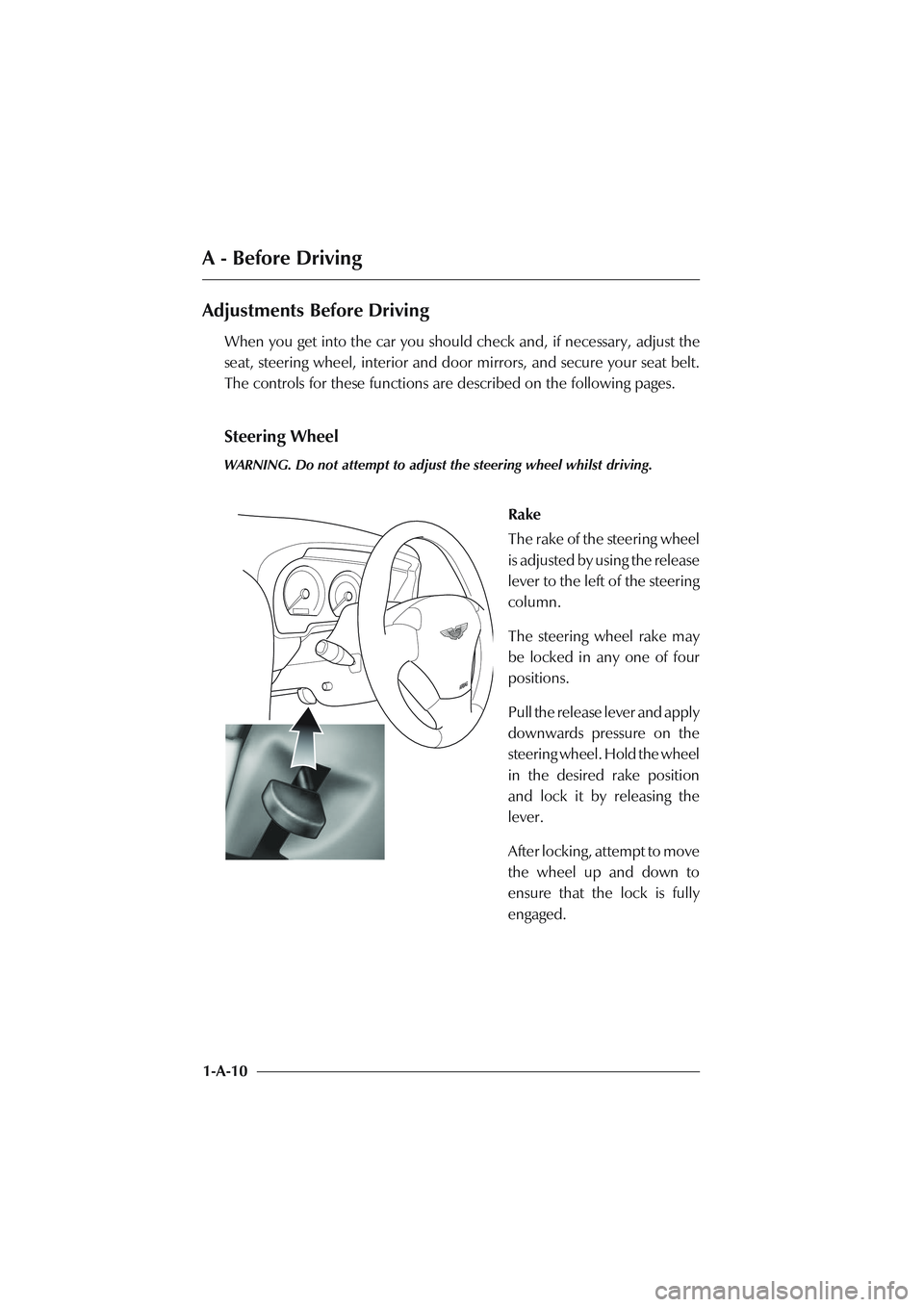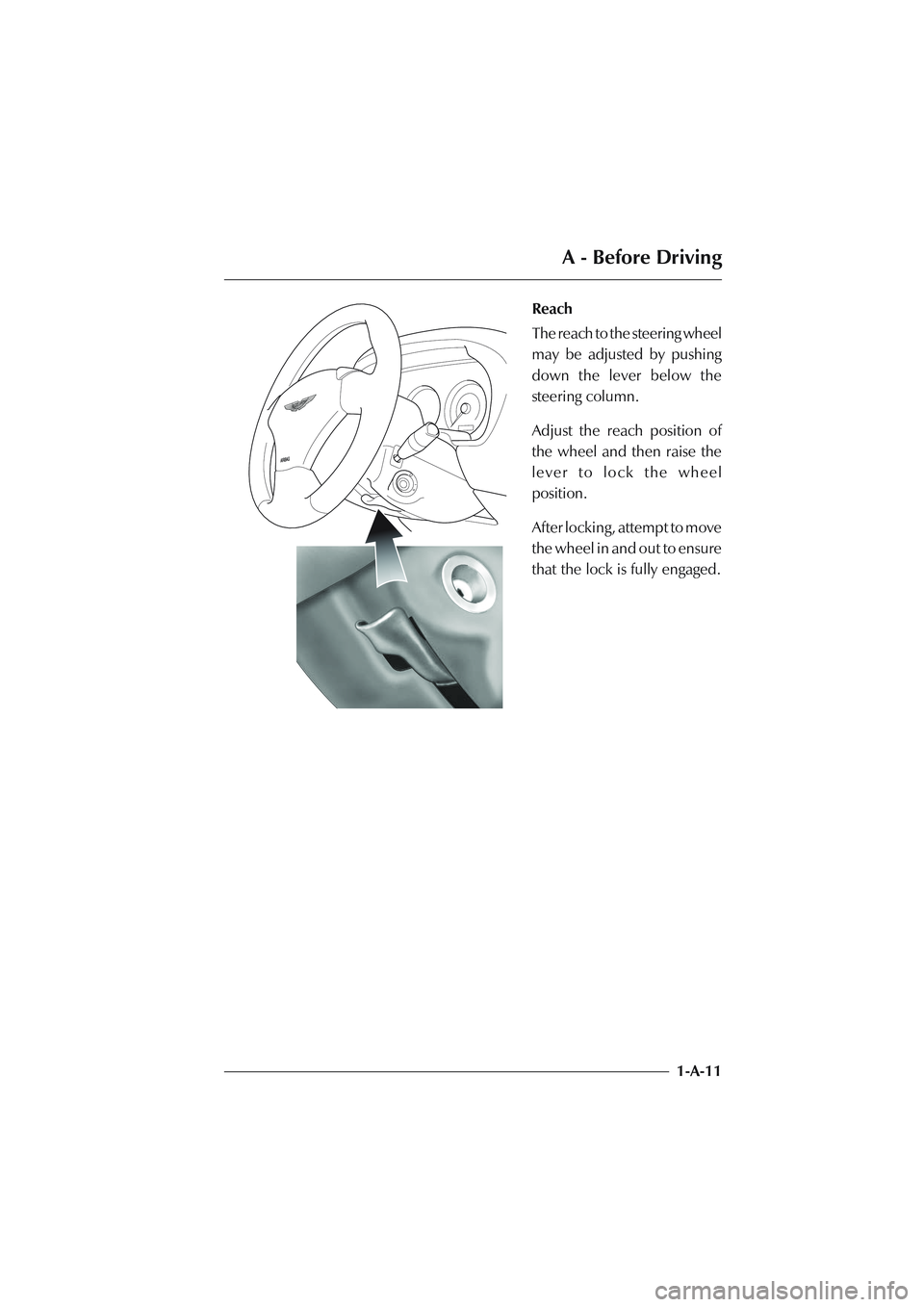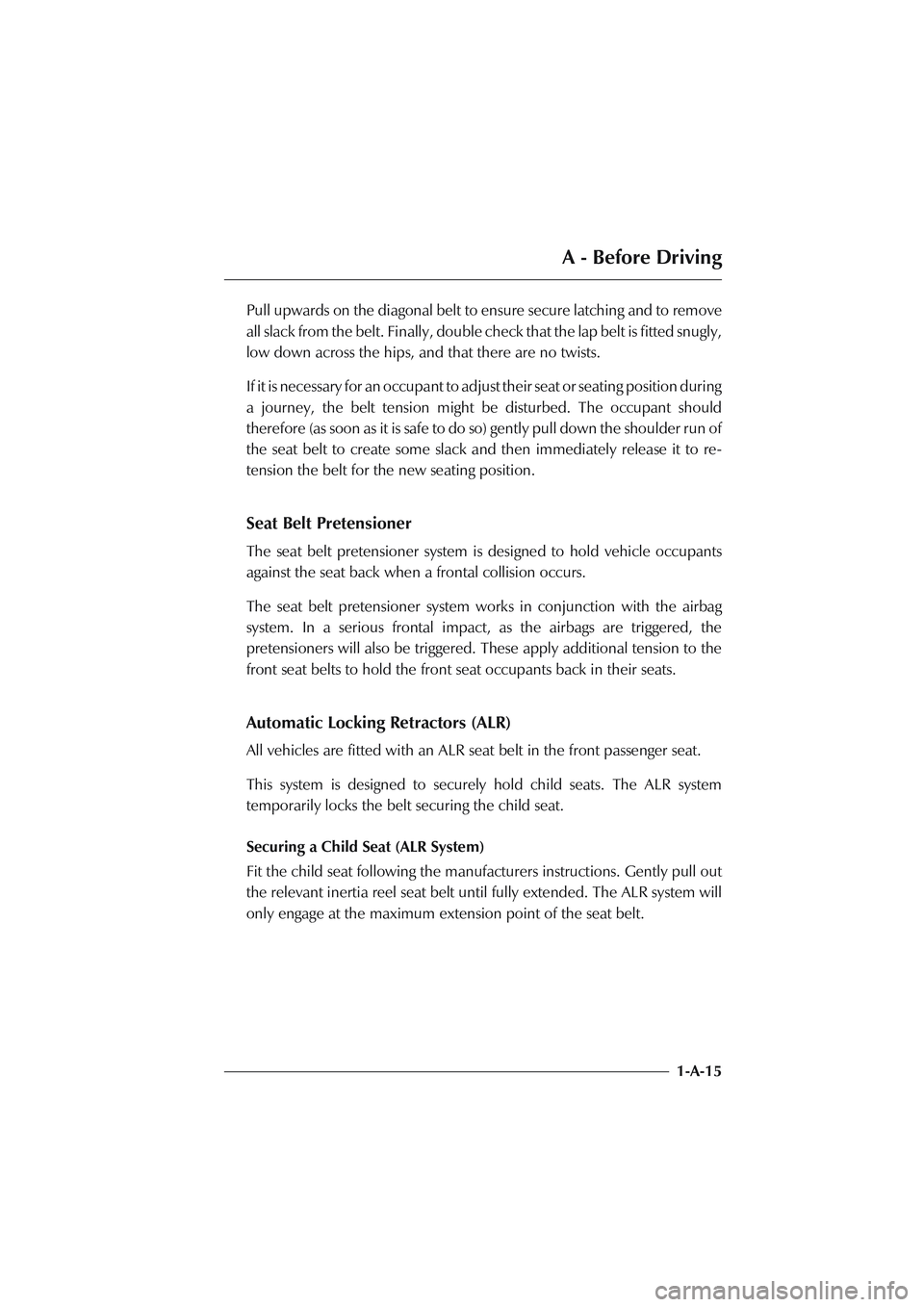lock ASTON MARTIN DB AR1 Q 2003 Owners Guide
[x] Cancel search | Manufacturer: ASTON MARTIN, Model Year: 2003, Model line: DB AR1 Q, Model: ASTON MARTIN DB AR1 Q 2003Pages: 279, PDF Size: 3.77 MB
Page 13 of 279

A - Before Driving
1-A-1
Contents
Vehicle Keys ....................................................................................... 1-A-2
The Security System and Door Locks .................................................. 1-A-3
Rain Cover ......................................................................................... 1-A-7
Adjustments Before Driving .............................................................. 1-A-10
Seat Belts .......................................................................................... 1-A-14
Airbags............................................................................................. 1-A-20
Interior Storage ................................................................................. 1-A-22
Page 15 of 279

A - Before Driving
1-A-3
The Security System and Door Locks
Your DB AR1 is fitted with sophisticated security systems which protect your
car against theft. The alarm system is linked to the central locking system.
The following two pages describe the basic operations required to turn on
or off the alarm and at the same time to lock or unlock the car. The systems
are fully described in section 'E - Security Systems'.
Alarm Key Fob
Basic alarm functions are controlled using the alarm key fob which sends
radio signals to the alarm unit aerial near the rear window when either the
left or right key fob button is pressed.
The left button is used for turning the alarm system on/off and locking/
unlocking the car. The right button is used for unlocking the boot.
The key fob has a range of about 10 metres (30 feet) when operating with
no intervening obstructions.
Page 16 of 279

A - Before Driving
1-A-4
Unlocking the Car / Turning off the Alarm
To unlock the car and turn the alarm system off, approach to within 10
metres (30 feet) of the car and point the key fob towards the rear window.
Press the left button on the alarm key fob.
The exterior direction indicators flash three times, indicating that the alarm
has been switched off. At the same time, the central locking system unlocks
the car doors and fuel filler flap. Alarm sensing on the boot lock is also
switched off so that the boot may be opened without triggering the alarm.
Locking the Car / Turning on the Alarm
To turn the alarm system on and lock the car, stand within 10 metres (30 feet)
of the car and point the key fob towards the rear window. Press the left
button on the alarm key fob.
The direction indicators flash once as the alarm is switched on. Alarm
sensing is then operative on the door locks, bonnet and boot. At the same
time, the car doors, boot and filler flap are locked by the central locking
system.
Engine Immobiliser
The engine is immobilised by the Passive Anti-Theft System (PATS) and may
not be started until a correctly coded key is inserted and turned in the
ignition switch (See 'Security Systems' for a full description of PATS). The
PATS system is fully automatic and requires no intervention from the driver.
Page 17 of 279

A - Before Driving
1-A-5
Door Locks
The door locks and fuel filler flap are centrally controlled and are normally
unlocked when the left button is pressed on the alarm key fob. The boot lock
is also enabled at this time but does not release until opened using the boot
release switch, ignition key or by pressing the right button on the key fob.
NOTE: If a door is unlocked and opened with the key whilst the alarm is switched
on, the alarm will sound.
If the alarm system is off, then locking or unlocking of either door with the
ignition key causes simultaneous locking or unlocking of the other door and
the fuel filler flap by means of the central locking system.
Door Sealing
Your DB AR1 is fitted with frameless door windows. A special door sealing
system is fitted to ensure a tight fit of the door glass to the seal along the 'A'
post.
When you open a door, the window glass is automatically lowered a few
millimetres to clear the door seal.
As you close a door, the window glass is automatically raised against the
body frame rubber seals.
WARNING: Ensure that all occupants are clear when the window mechanism is
operating.
Caution: Door Seal Damage - Reconnect the battery (see Battery Reconnect Switch
1-F-35) before opening the doors to avoid damage to the door seals.
Page 18 of 279

A - Before Driving
1-A-6
Interior Door Handles and Locks
To open either car door from inside, pull on the release lever and push
outwards on the door.
Locking the Doors when Inside the Car
If you wish to lock the car doors from inside the vehicle, push the lock tab
on the release lever towards the rear of the car. This will activate the central
locking system and lock both doors and the fuel filler flap.
WARNING: The interior door handle will also be disabled at this time.
Pushing the lock tab towards the front of the car will unlock the doors and
fuel filler flap.
Page 19 of 279

A - Before Driving
1-A-7
Rain Cover
To protect the interior of your DB AR1 during periods of inclement weather
a rain cover is provided.
WARNING. Aston Martin recommend that your DB AR1 is not to be driven while
the rain cover is installed.
If it is essential that your DB AR1 is to be moved with the rain cover installed, i.e.
to move to a safe parking area or into a covered area, do not exceed 5 m.p.h. and
only drive a very short distance. The front of the rain cover, over the windscreen,
can be rolled up, allowing the driver to have vision.
To Fit the Rain Cover
Before fitting the rain cover raise both door windows fully and remove the
ignition key from the ignition lock.
1. Remove the rain cover from its storage bag.
Place the rain cover over the windscreen,
black side up, with the two sucker
attachments towards the front of the vehicle.
Attach the suckers to the windscreen (one
in each bottom corner of the windscreen).
Note: Place the sucker attachments close to the
corners, this will enable the windscreen wipers to operate if required.
Page 22 of 279

A - Before Driving
1-A-10
Adjustments Before Driving
When you get into the car you should check and, if necessary, adjust the
seat, steering wheel, interior and door mirrors, and secure your seat belt.
The controls for these functions are described on the following pages.
Steering Wheel
WARNING. Do not attempt to adjust the steering wheel whilst driving.
Rake
The rake of the steering wheel
is adjusted by using the release
lever to the left of the steering
column.
The steering wheel rake may
be locked in any one of four
positions.
Pull the release lever and apply
downwards pressure on the
steering wheel. Hold the wheel
in the desired rake position
and lock it by releasing the
lever.
After locking, attempt to move
the wheel up and down to
ensure that the lock is fully
engaged.
Page 23 of 279

A - Before Driving
1-A-11
Reach
The reach to the steering wheel
may be adjusted by pushing
down the lever below the
steering column.
Adjust the reach position of
the wheel and then raise the
lever to lock the wheel
position.
After locking, attempt to move
the wheel in and out to ensure
that the lock is fully engaged.
Page 26 of 279

A - Before Driving
1-A-14
Seat Belts
The DB AR1 is fitted with two inertia reel seat
belts which automatically tension to provide
security with comfort. In the event of a collision
or during severe braking, the belt reel will lock.
A light on the instrument panel is illuminated
when the car is started and the driver's seat belt
is not fastened. There is also a brief reminder
buzzer that sounds at the same time.
Seat Belt Fastening
Sit upright with your back
fully in contact with the seat
back. Pull out the seat belt,
drawing the tongue over the
shoulder and across the chest.
Note: When parked on an
incline, the belt may lock as it is
withdrawn. This is not a fault. If
the mechanism locks, release the
belt tension and then pull gently
to avoid operation of the inertia
lock.
Push the tongue into the belt buckle latch until a positive click is heard.
Page 27 of 279

A - Before Driving
1-A-15 Pull upwards on the diagonal belt to ensure secure latching and to remove
all slack from the belt. Finally, double check that the lap belt is fitted snugly,
low down across the hips, and that there are no twists.
If it is necessary for an occupant to adjust their seat or seating position during
a journey, the belt tension might be disturbed. The occupant should
therefore (as soon as it is safe to do so) gently pull down the shoulder run of
the seat belt to create some slack and then immediately release it to re-
tension the belt for the new seating position.
Seat Belt Pretensioner
The seat belt pretensioner system is designed to hold vehicle occupants
against the seat back when a frontal collision occurs.
The seat belt pretensioner system works in conjunction with the airbag
system. In a serious frontal impact, as the airbags are triggered, the
pretensioners will also be triggered. These apply additional tension to the
front seat belts to hold the front seat occupants back in their seats.
Automatic Locking Retractors (ALR)
All vehicles are fitted with an ALR seat belt in the front passenger seat.
This system is designed to securely hold child seats. The ALR system
temporarily locks the belt securing the child seat.
Securing a Child Seat (ALR System)
Fit the child seat following the manufacturers instructions. Gently pull out
the relevant inertia reel seat belt until fully extended. The ALR system will
only engage at the maximum extension point of the seat belt.